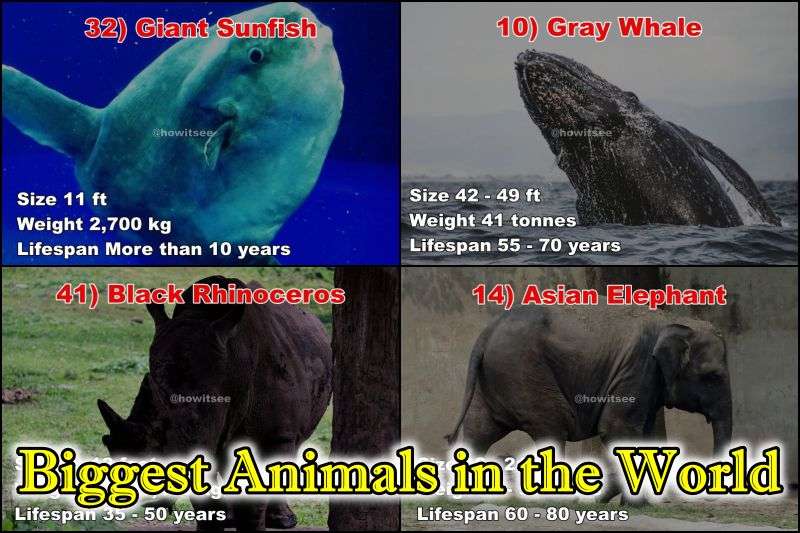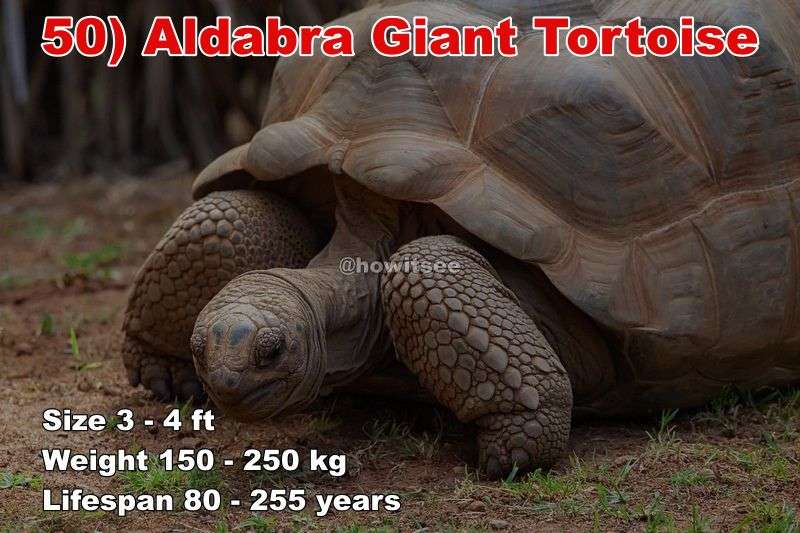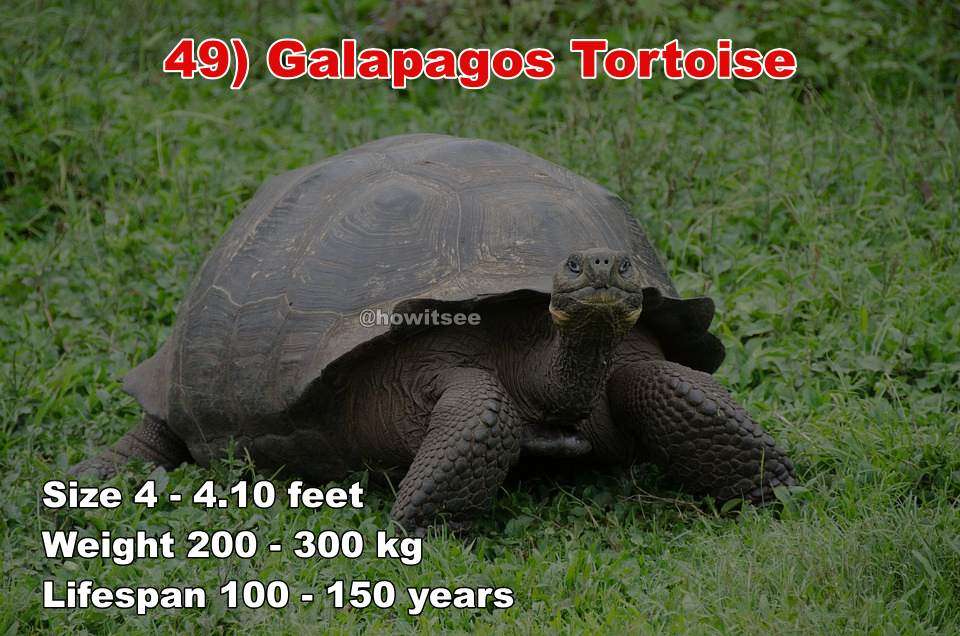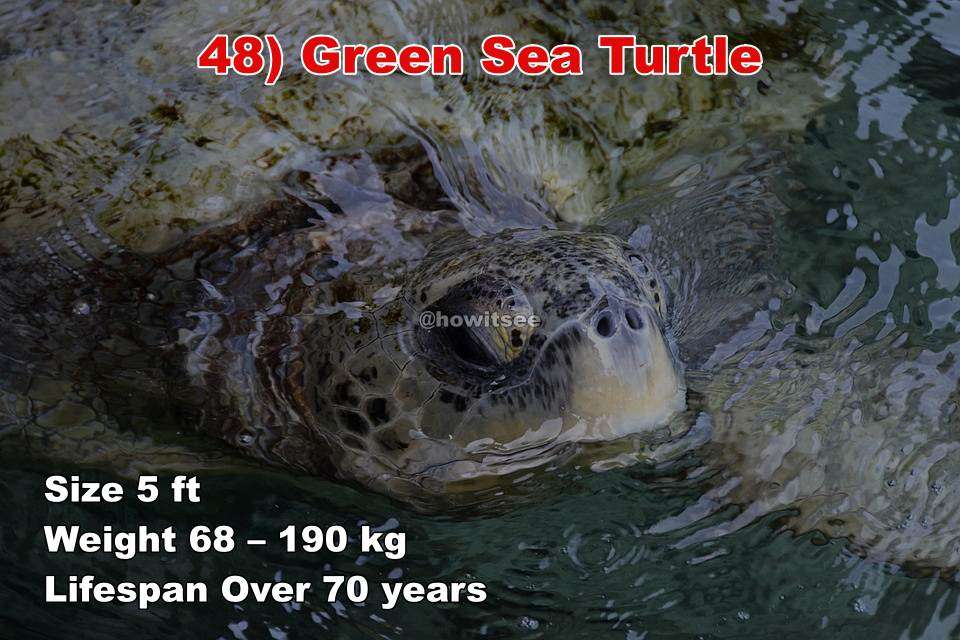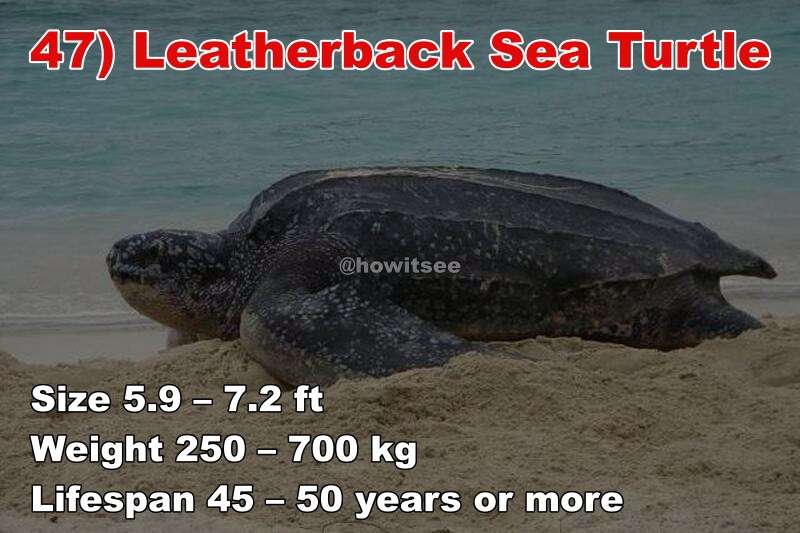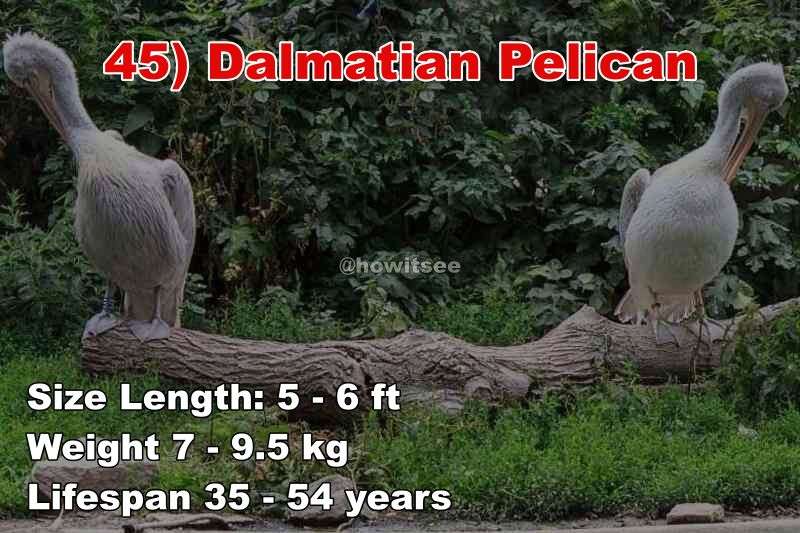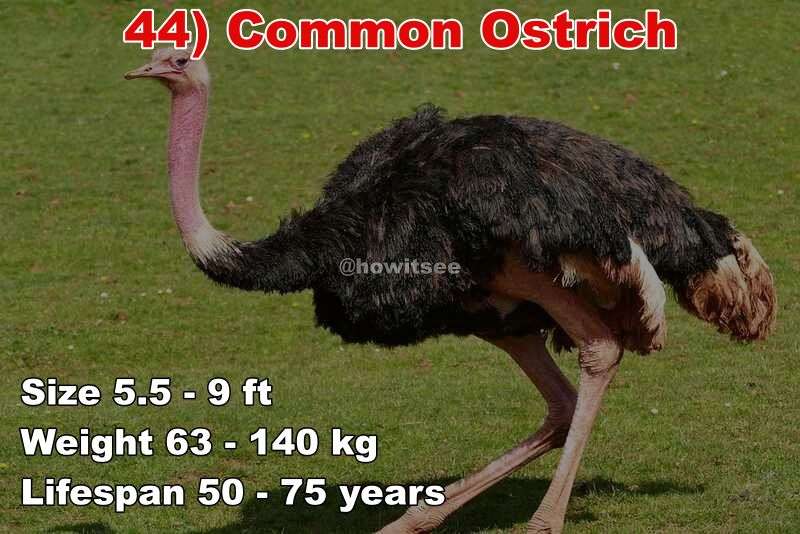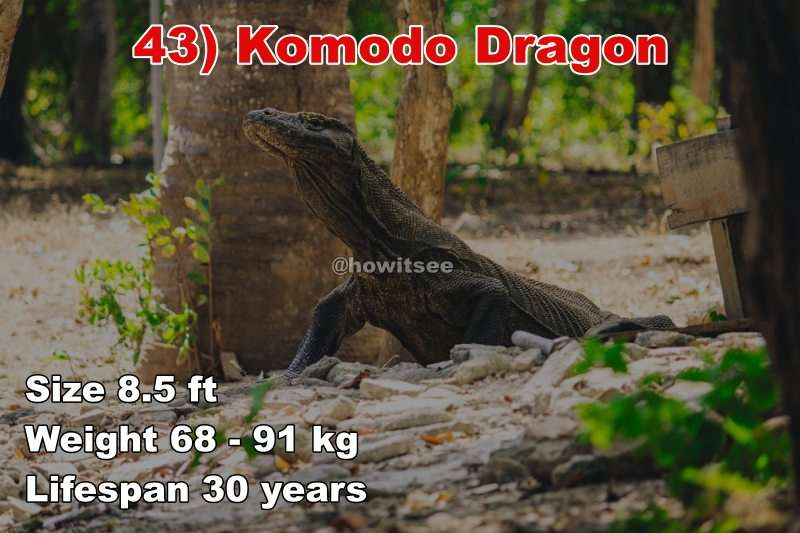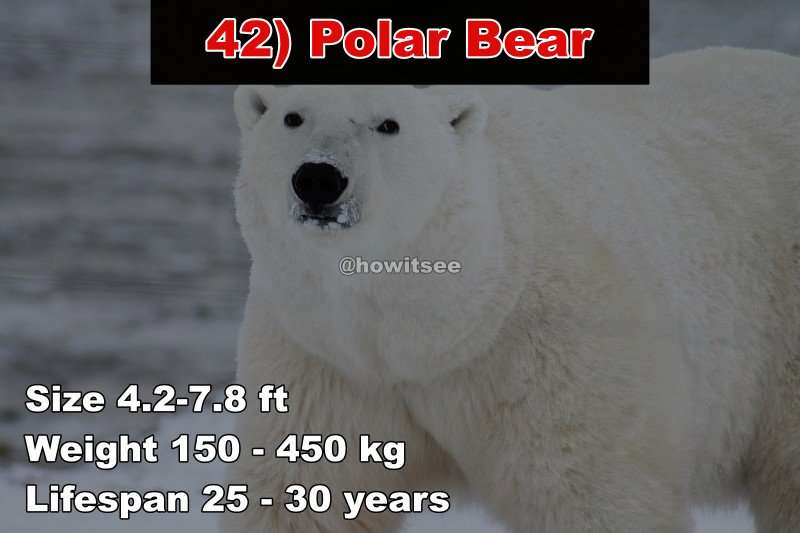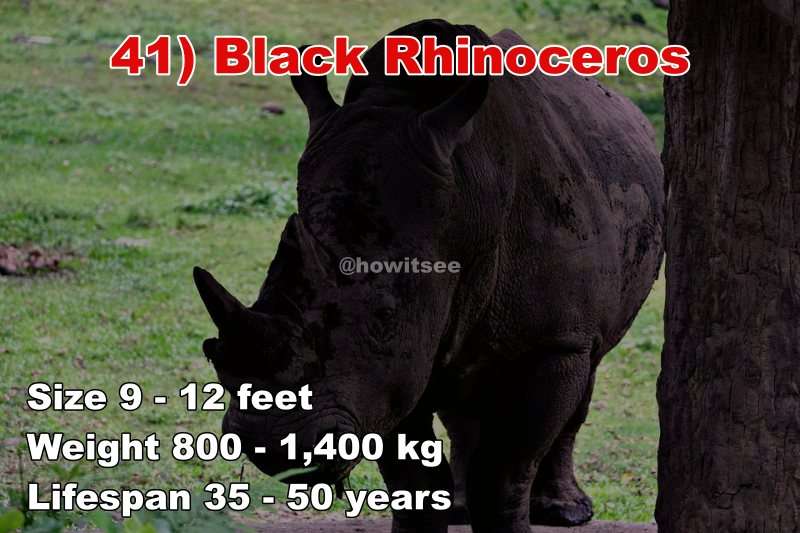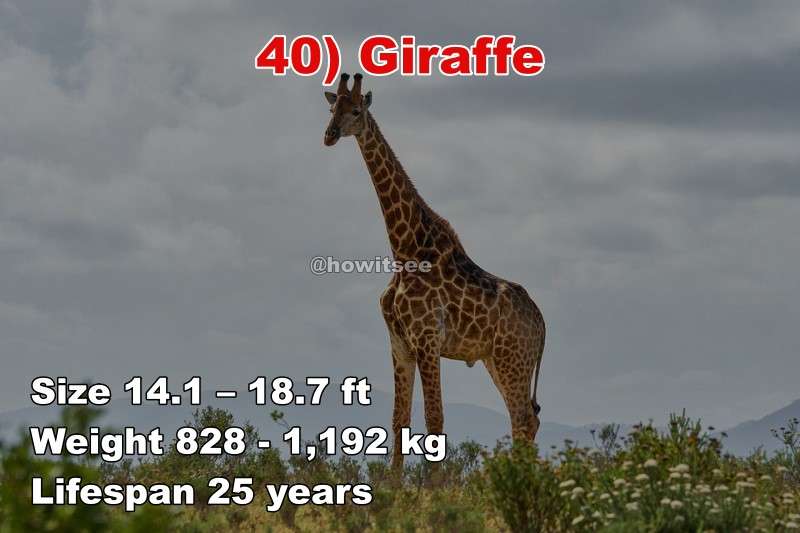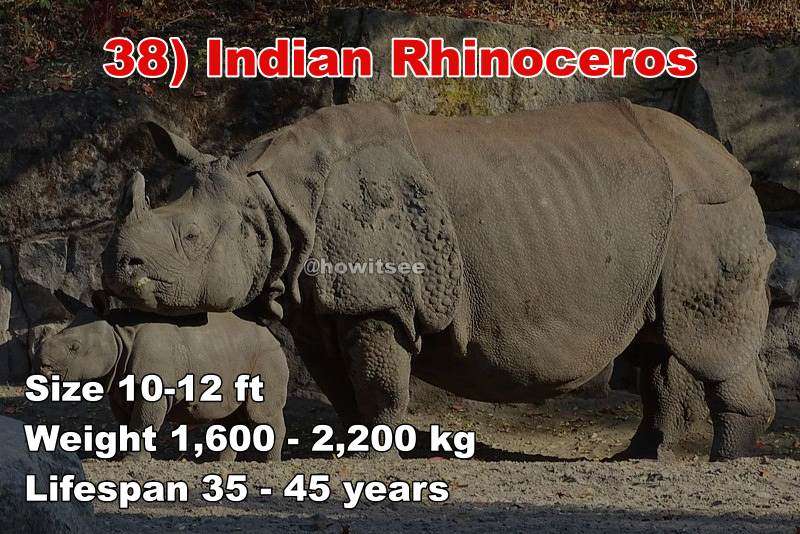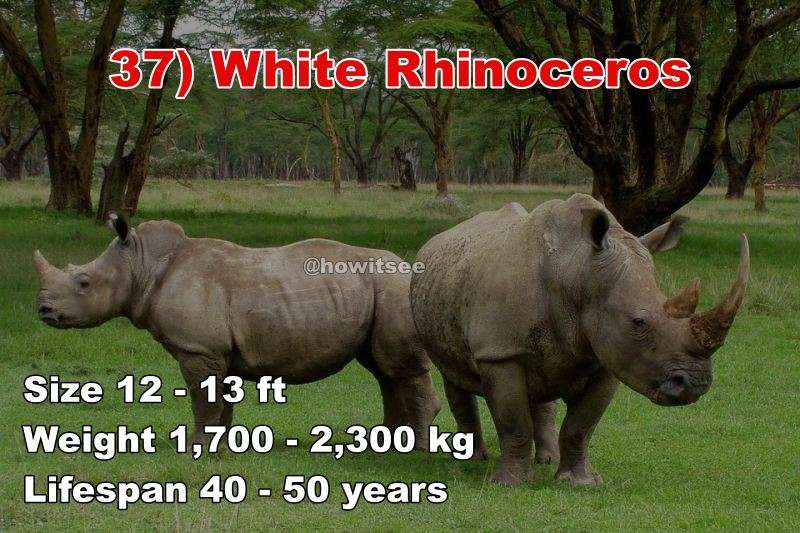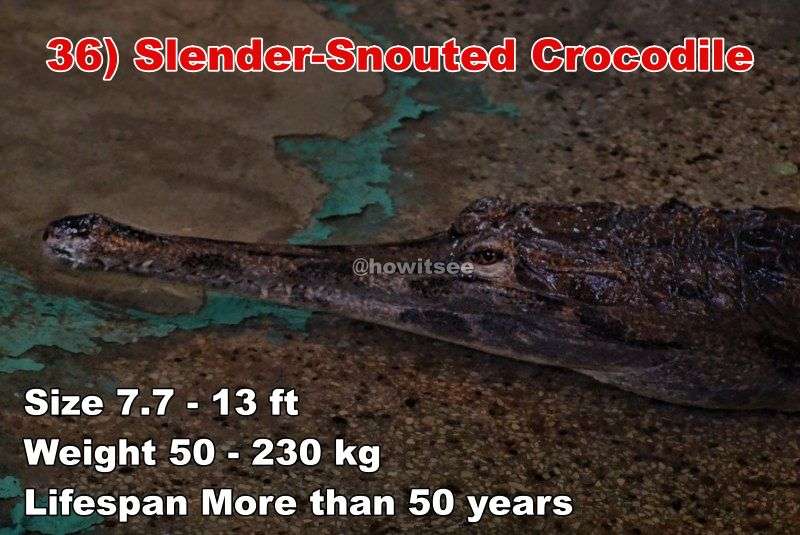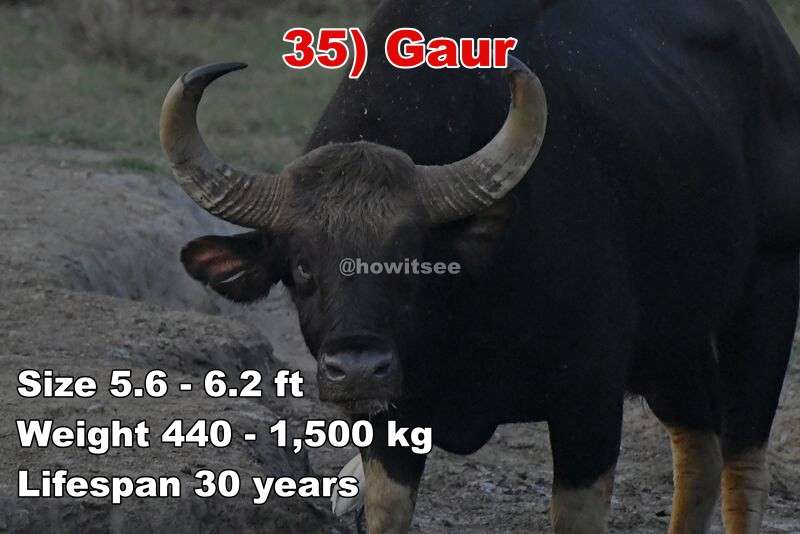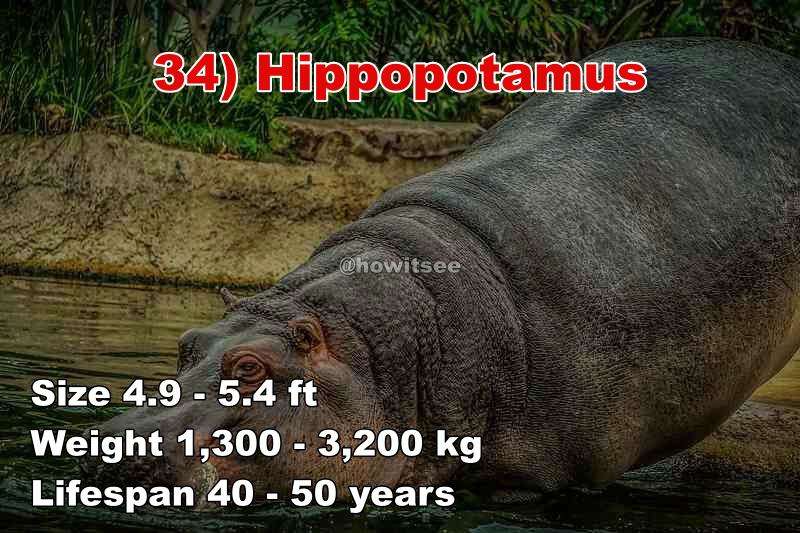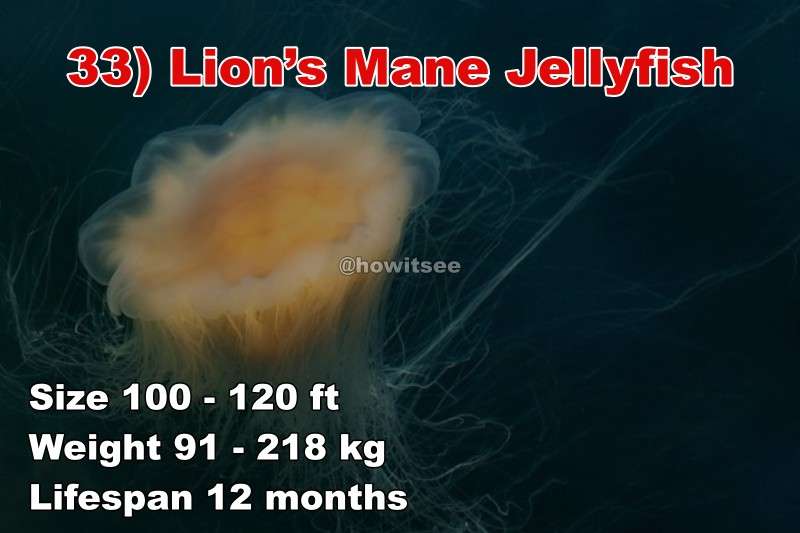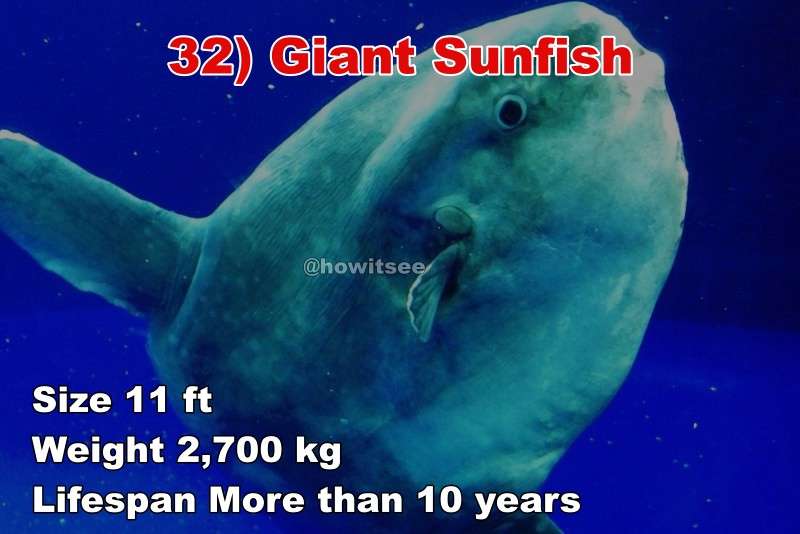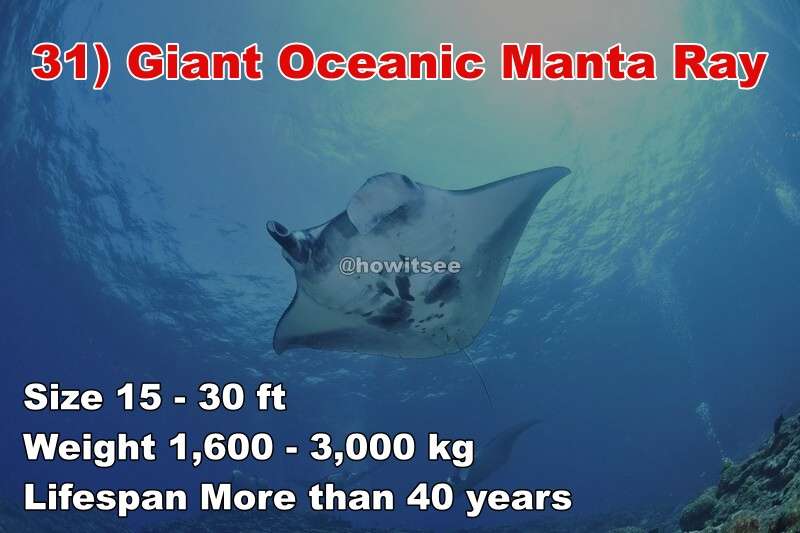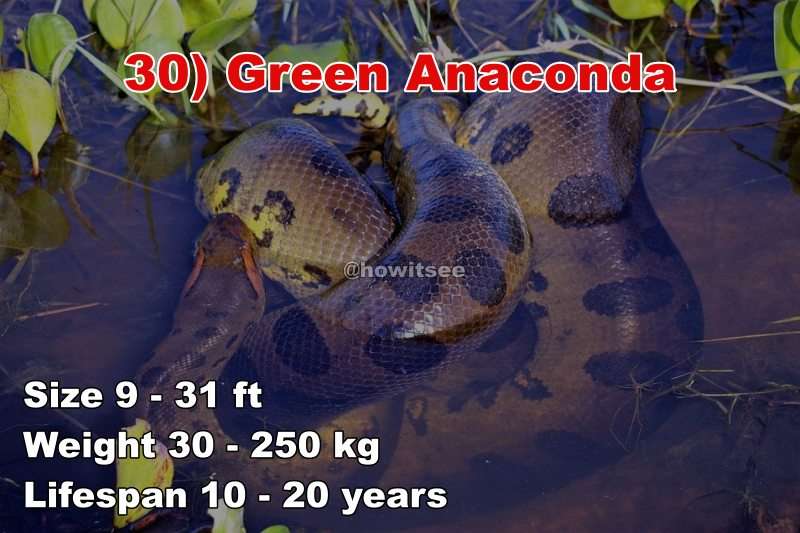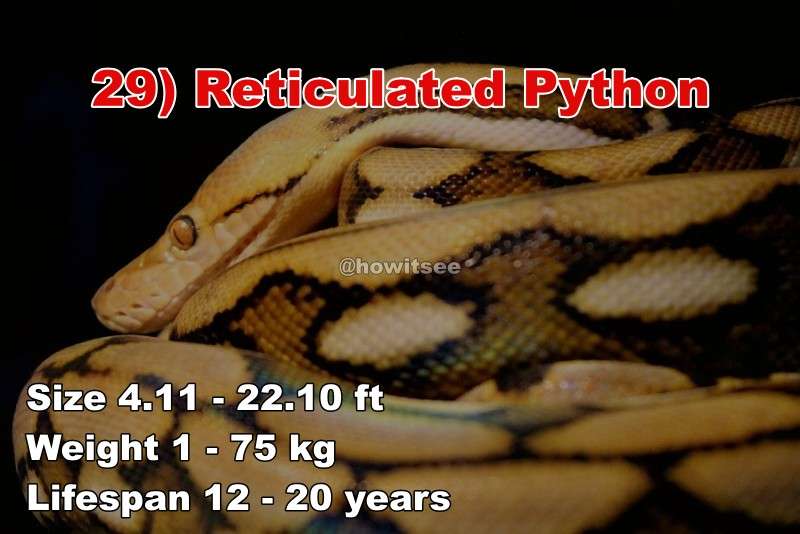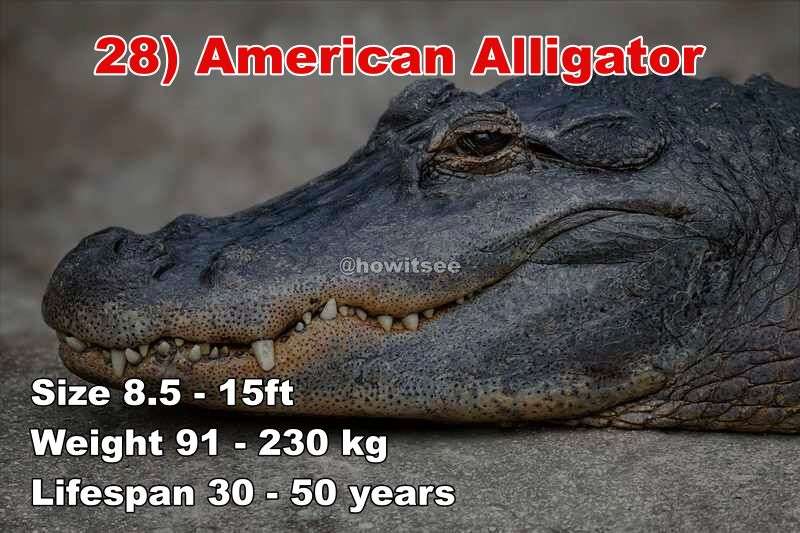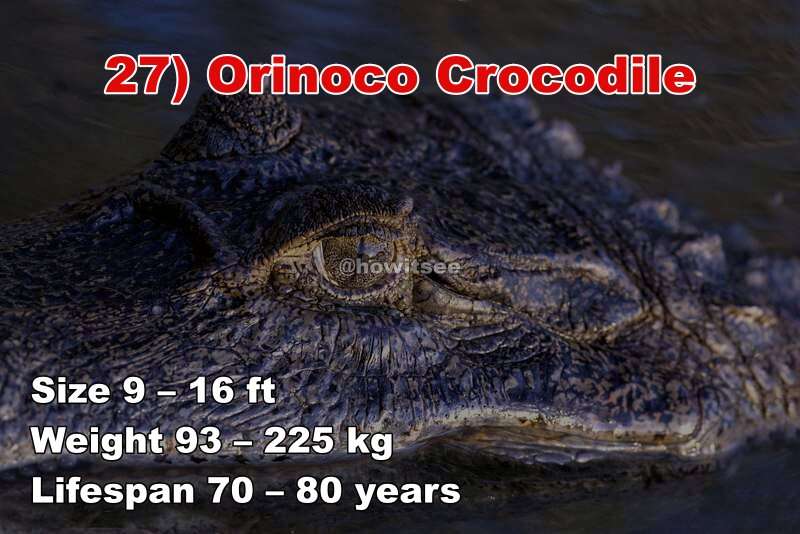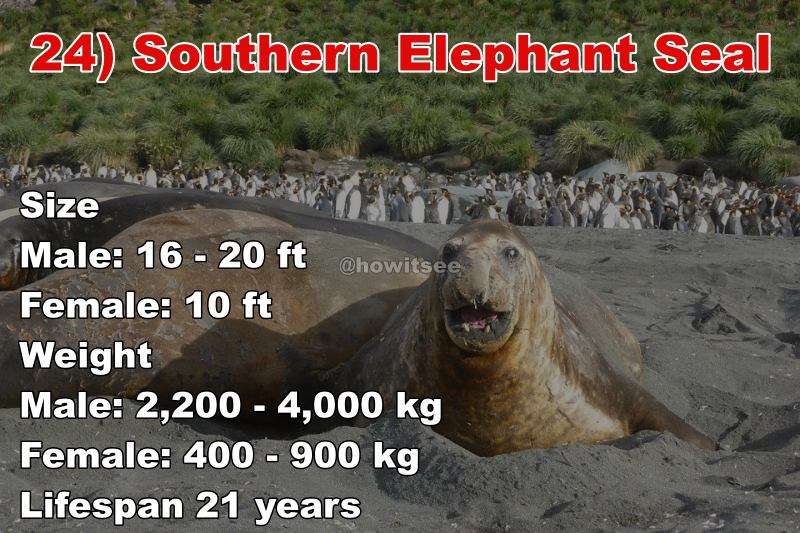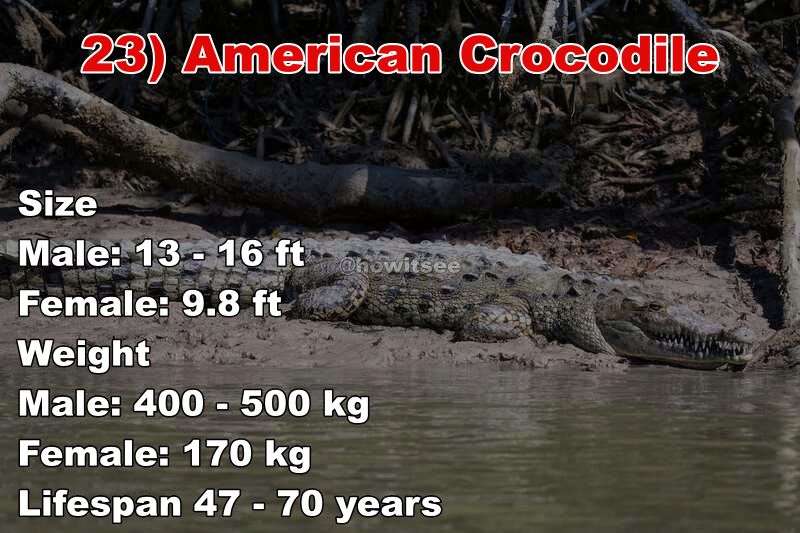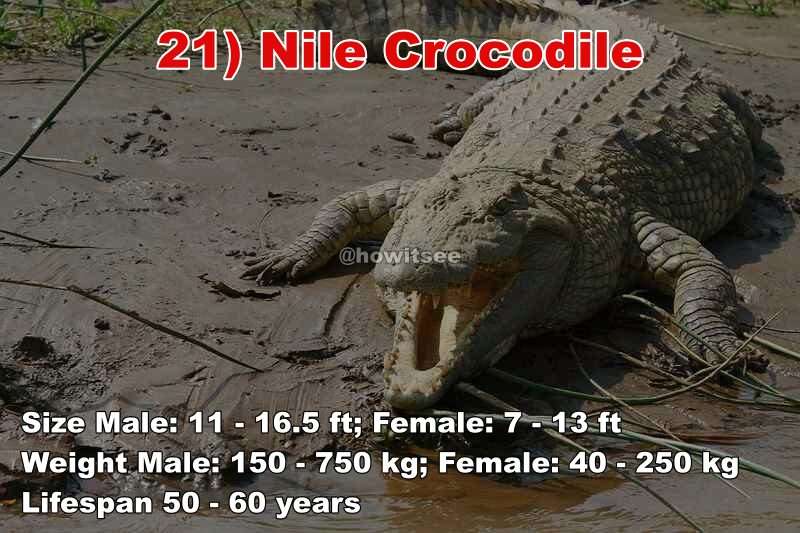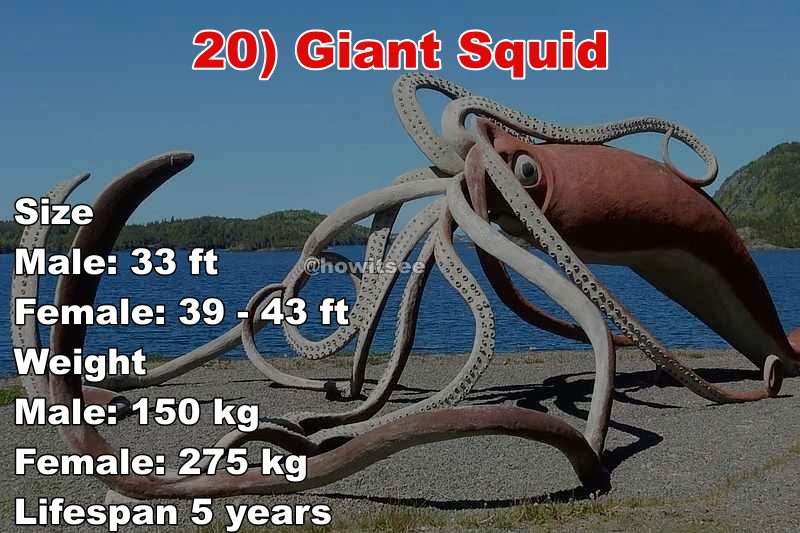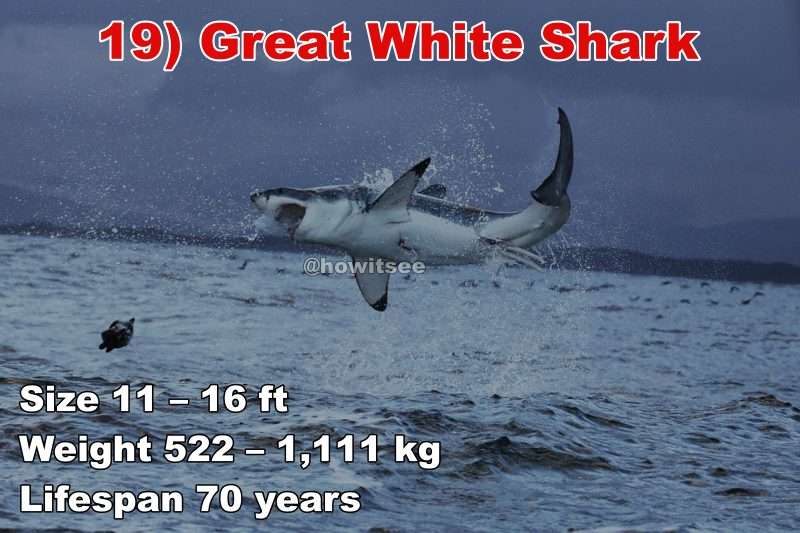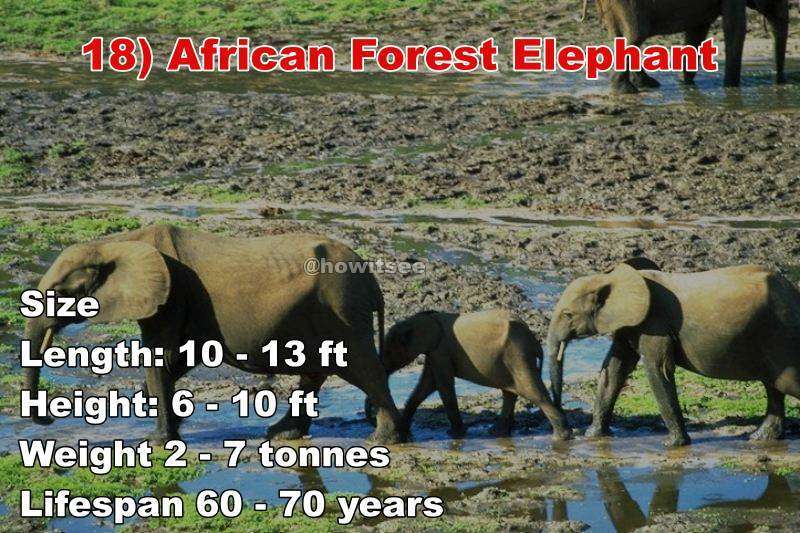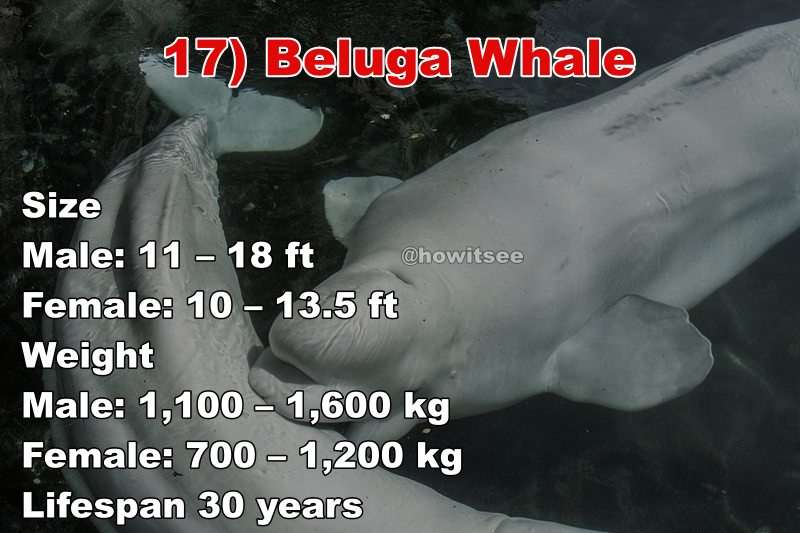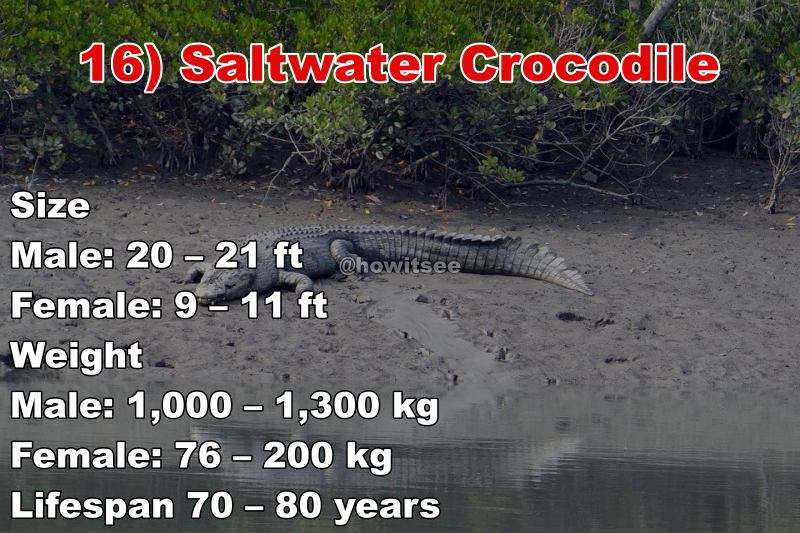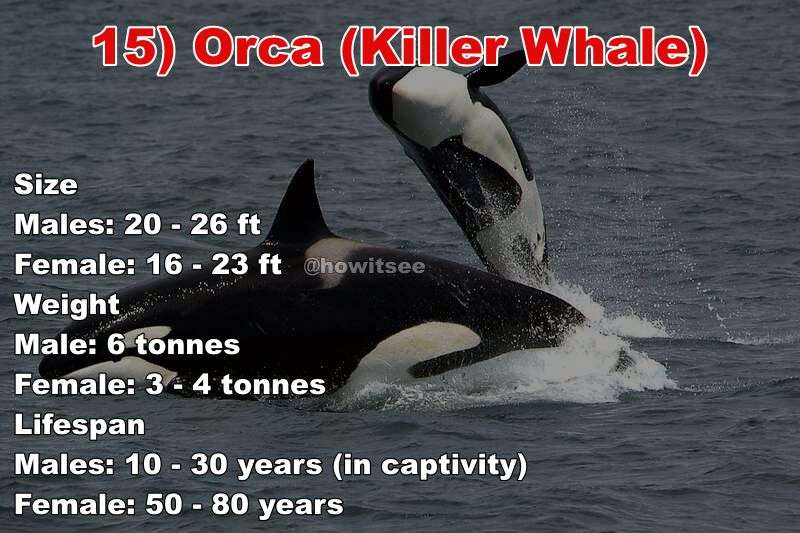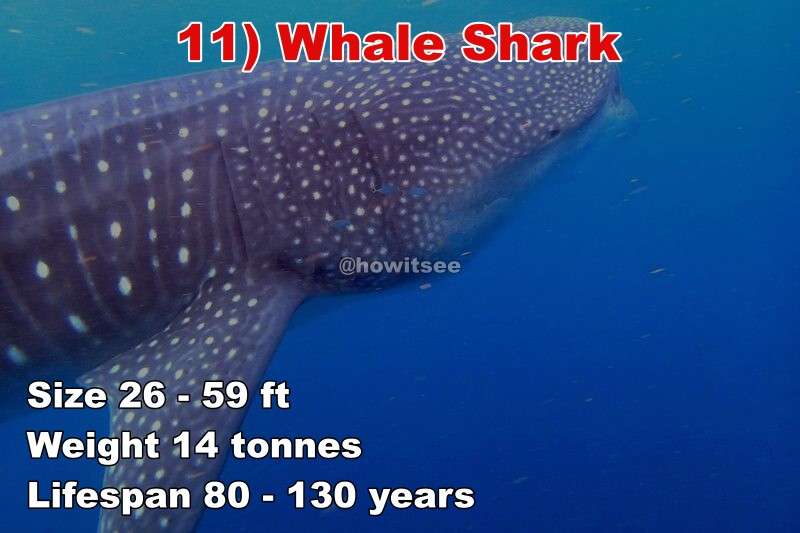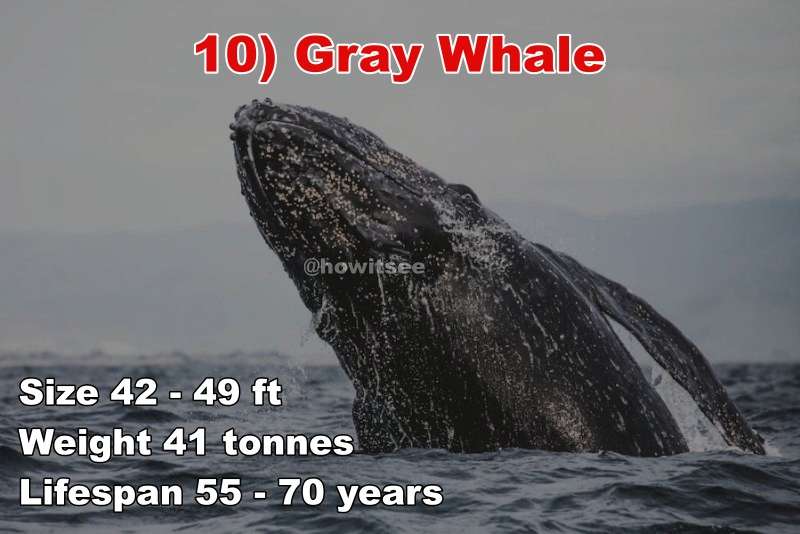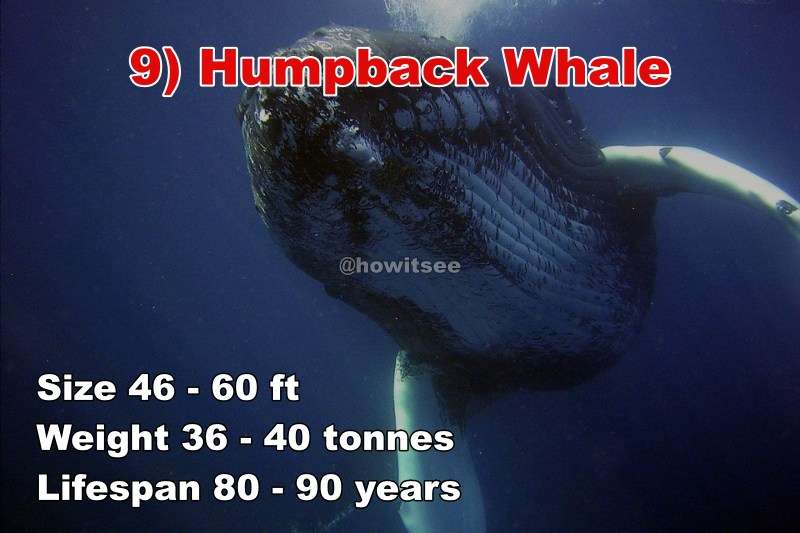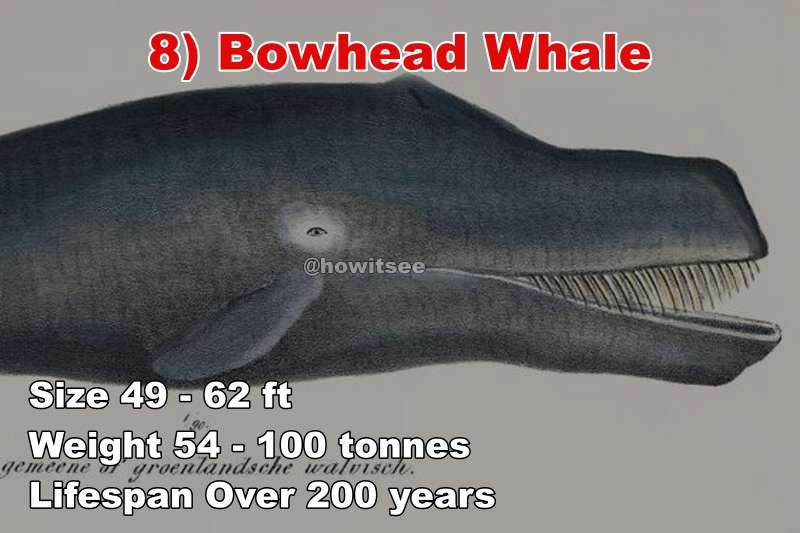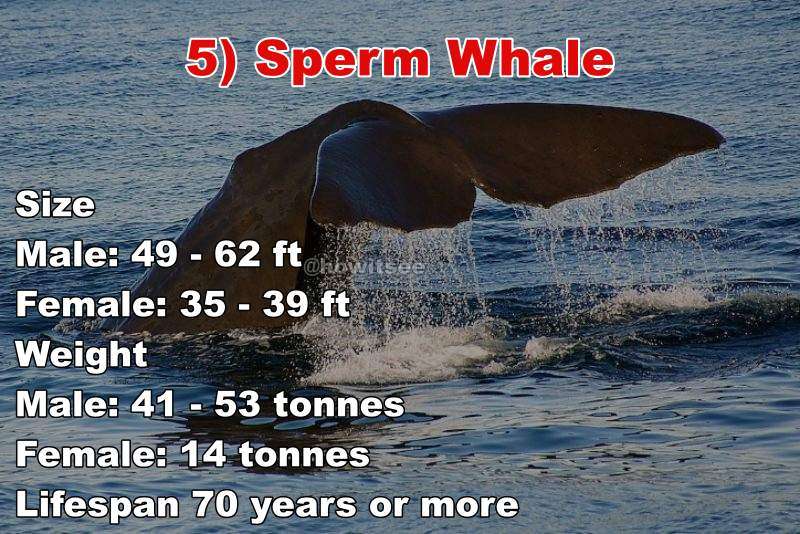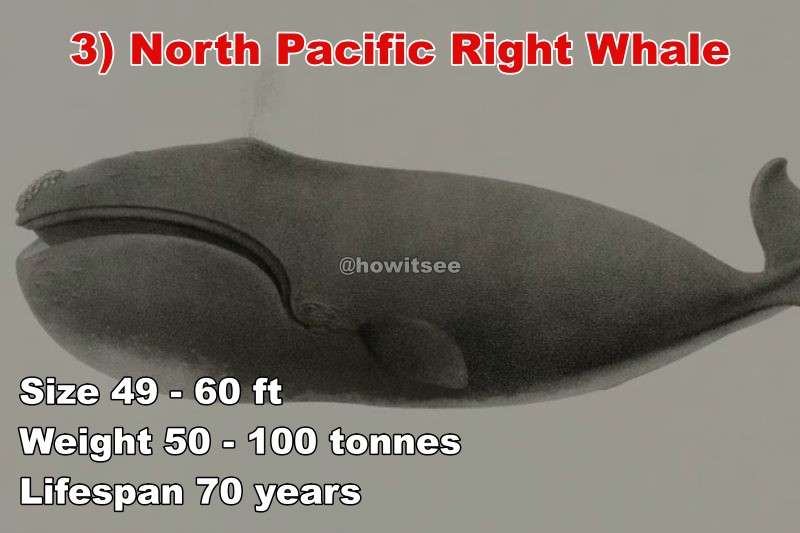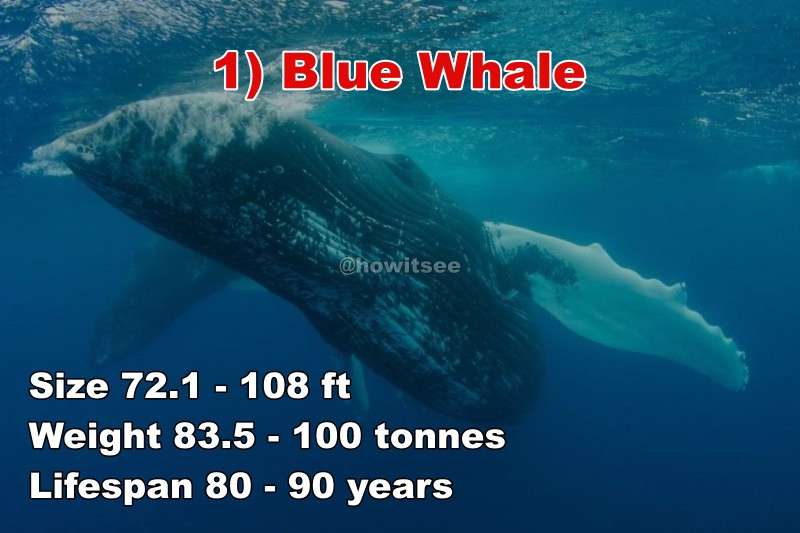Nature is astounding in its variety, and that seems all truer when we look at the different sizes and natures of living things. In the animal world, there are animals with hearts greater than a car’s size or can make noises louder than jet engines. There are also animals who can’t even be seen without being put under a microscope. For today, though, we’ll be looking at the large animals. We’ll be talking about the top 60 biggest animals in the world, all ranked in order.
To make that list, we’ll not only be looking at their lengths but also their body mass and will be taking the average size of their species into consideration. So, without further delay, let’s look at the list
Top 60 Biggest Animals in the World Ranked
60) Aldabra Giant Tortoise
| Scientific name |
Aldabrachelys gigantea |
| Size | 3 – 4 ft |
| Weight | 150 – 250 kg |
| Lifespan | 80 – 255 years |
| Diet | Vegetation |
Aldabra Giant Tortoise is one of the largest tortoise species in the world, endemic only to Aldabra Atoll Islands in Seychelles. These herbivorous tortoises are quite small in number and listed as a Vulnerable species in IUCN’s Red List.
59) Galapagos Tortoise
| Scientific name | Chelonoidis niger |
| Size | 4 – 4.10 feet |
| Weight | 200 – 300 kg |
| Lifespan | 100 – 150 years |
| Diet | Vegetation |
The largest species of tortoise are endemic to the Galapagos Islands. The Galapagos Tortoises are believed to show gigantism as the closest relatives of this species are almost 100 times smaller than their current average size.
58) Green Sea Turtle
| Scientific name | Chelonia mydas |
| Size | 5 ft |
| Weight | 68 – 190 kg |
| Lifespan | Over 70 years |
| Diet | Juveniles are carnivorous and adults are omnivorous |
Green Sea Turtles are the only herbivorous turtle species. They are also one of the largest turtles and one of the biggest animals in the world. Their paddle-like limbs are called flippers and these help them moving in the water smoothly.
57) Leatherback Sea Turtle
| Scientific name | Dermochelys coriacea |
| Size | 5.9 – 7.2 ft |
| Weight | 250 – 700 kg |
| Lifespan | 45 – 50 years or more |
| Diet | Jellyfish, cnidarians, tunicates, cephalopods, crustaceans, fish, sea urchins, snails |
Leatherback Sea Turtles are the largest turtle species in the world. They can travel long distances and prefer to stay in the water, the female turtles only coming to the shore to lay eggs. These turtles are also the only species not to have hard shells and scales.
56) Andean Condor
| Scientific name | Vultur gryphus |
| Size | Wingspan: 8.8 – 10 ft
Length: 3.3 – 4.2 ft |
| Weight | 7.7 – 15 kg |
| Lifespan | Over 70 years |
| Diet | Decaying flesh of rotting animals |
Andean Condors are inhabitants of South America, along the Andes Mountains range. These vultures are scavengers in nature and have the longest wingspan among the raptors. Currently, there are quite a small number of Andean condors left in the world, making them one of the Near Threatened species.
55) Dalmatian Pelican
| Scientific name | Pelecanus crispus |
| Size | Wingspan: 11.5 ft
Length: 5 – 6 ft |
| Weight | 7 – 9.5 kg |
| Lifespan | 35 – 54 years |
| Diet | Common carp, European perch, eels, mullets, common rudds, pike, other fish, amphibians, worms, small water birds, crustaceans |
Though some largest specimens of swans rival the length and weight of the Dalmatian Pelican, these pelicans are noted to be the largest freshwater bird in the world. They are also the largest in the pelican family. The Dalmatian pelicans have a harsh birdcall which becomes sharper and clearer during their mating season.
54) Common Ostrich
| Scientific name | Struthio camelus |
| Size | Height: Male: 6.8 – 9 ft; Female: 5.5 – 6.5 ft
Wingspan: 6.5 ft |
| Weight | 63 – 140 kg |
| Lifespan | 50 – 75 years |
| Diet | Vegetation, insects |
The Common Ostriches are known for being the largest bird species still alive and their flightless nature. They are native to the continent of Africa. The common ostriches are also the fastest birds on land, having an average speed of 34 mph with short bursts of 43 mph.
53) Komodo Dragon
| Scientific name | Varanus komodoensis |
| Size | Male: 8.5 ft; Female: 7.5 ft |
| Weight | Male: 79 – 91 kg; Female: 68 – 73 kg |
| Lifespan | 30 years |
| Diet | All kinds of meat, animal carcass, small lizards, snakes, birds, insects |
The largest lizard in the world is the Komodo Dragon. They are endemic to only a few Indonesian islands. These lizards are venomous and secrete toxic proteins and anticoagulants from their lower jaw.
52) Elk
| Scientific name | Cervus canadensis |
| Size | 0.75 to 1.5 meters |
| Weight | Males: 178 to 497 kilograms
Females: 171 to 292 kilograms |
| Lifespan | 10 to 13 years in the wild, but they can live up to 20 years or more in captivity. |
| Diet | Native grasses, tree bark in winter, forbs and tree sprouts. |
Elk have adapted well to countries where they have been introduced, including Argentina and New Zealand.
While once believed to be a subspecies of the European red deer, genetic studies starting in 1998 established that elk (Cervus canadensis) and red deer (Cervus elaphus) are distinct species.
The morphological differences, such as a wider rump patch and paler-hued antlers, distinguish elk from their European counterparts.
51) Clydesdale Horse
| Scientific name | Equus ferus caballus |
| Size | 162 to 183 cm (16.0 to 18.0 hands) |
| Weight | 820 to 910 kg (1800 to 2000 lb), with some mature males being larger and weighing up to 1000 kg (2200 lb). |
| Lifespan | 20-30 years |
| Diet | Hay, grains, and other feeds |
Clydesdales have a rich history and were initially bred in Scotland by mating Flemish stallions with local mares in the 18th century. Shire blood was later introduced in the 19th century, influencing the breed’s characteristics.
They are not only known for their strength and utility in agriculture but have gained fame as show horses and parade horses.
50) Polar Bear
| Scientific name | Ursus maritimus |
| Size | Male: 4.2 ft
Female: 5.9 – 7.8 ft |
| Weight | Male: 450 kg
Female: 150 – 250 kg |
| Lifespan | 25 – 30 years |
| Diet | Arctic fox, seals |
Native to the Arctic circle, Polar Bears are the only species of bears to be considered as marine animals. They have a hypercarnivorous diet and are very aggressive. Because of climate change and habitat loss, they are currently a Vulnerable species, according to IUCN.
Note: Here, we are taking Grizzly Bear, Pandas and other Black bears in this point.
49) Moose
| Scientific name | Alces alces |
| Size | Adult moose is somewhere between 1.4 to 2.1 meters |
| Weight | Males: 380 to 700 kg (838 to 1,543 lb)
Females: 200 to 490 kg (441 to 1,080 lb) |
| Lifespan | The lifespan of a moose is around 15 to 25 years in the wild. |
| Diet | Terrestrial and aquatic vegetation, including forbs, non-grasses, and fresh shoots from trees like willow and birch. |
The moose is the tallest land mammal in North America, surpassing even the American buffalo in terms of height.
It’s an excellent swimmer and is capable of diving over 5.5 meters (18 ft) to reach plants on lake bottoms, making it the only deer species that can feed underwater.
48) Black Rhinoceros
| Scientific name | Diceros bicornis |
| Size | 9 – 12 feet |
| Weight | 800 – 1,400 kg |
| Lifespan | 35 – 50 years |
| Diet | Vegetation |
The name of the Black Rhinoceroses can be misleading since they are not actually black, but brown or gray in color. They are natives of Africa, inhabiting many countries of the continent. Black rhinos have pointed or hooked lips, leading to their name, hook-lipped rhinoceros.
47) Giraffe
| Scientific name | Giraffa sp. |
| Size | 14.1 – 18.7 ft |
| Weight | 828 – 1,192 kg |
| Lifespan | 25 years |
| Diet | Vegetation (also chews old bones) |
Giraffes are the tallest animals in the world, their height being a byproduct of their long necks. They prefer to stay in groups and are quite fast, running at the speed up to 35 mph. The spots of their bodies are unique to each individual and have blood vessels under which help them regulate body temperature.
46) Siberian Tiger
| Scientific name | Panthera tigris tigris |
| Size | Males: 195 cm (77 in)
Females: 174 cm (69 in) |
| Weight | Males: 180 to 306 kg
Females: 100 to 167 kg |
| Lifespan | 16 to 18 years in the wild, while in captivity, they may live up to 25 years. |
| Diet | Manchurian wapiti, Siberian musk deer, long-tailed goral, moose, Siberian roe deer, sika deer, and wild boar. |
The Siberian tiger is genetically close to the now-extinct Caspian tiger, and a phylogeographic study suggests that their common ancestor colonized Central Asia from eastern China, moving towards Siberia to establish the Siberian tiger population in the Russian Far East.
Historically, Siberian tigers were found throughout the Korean Peninsula and parts of North-Eastern China, but today, their population is concentrated mainly in the Sikhote-Alin mountain region in the Russian Far East.
45) Javan Rhinoceros
| Scientific name | Rhinoceros sondaicus |
| Size | Height: 4.6 – 5.6 ft
Length: 6.5 – 13 ft |
| Weight | 900 – 2,300 kg |
| Lifespan | 30 – 45 years |
| Diet | Vegetation |
While every rhino species is facing decreasing numbers, no one is more affected than the Javan Rhinoceros. These natives of Southeast Asia are currently very few in numbers and listed as Critically Endangered. They share the same genus with the Indian rhino but their horns and overall size are smaller than their relatives.
44) Indian Rhinoceros
| Scientific name | Rhinoceros unicornis |
| Size | Height: Male: 5.2 – 6.2 ft; Female: 4.9 – 5.5 ft
Length: Male: 12 ft; Female: 10 – 11 ft |
| Weight | Male: 2,200 kg; Female: 1,600 kg |
| Lifespan | 35 – 45 years |
| Diet | Vegetation |
Indian Rhinoceroses are natives of the Indian subcontinent and are one of the biggest animals in the world. They are famous for their single, large horn. But due to poaching and the threat of habitat loss, their numbers are decreasing, leading them to be considered a Vulnerable species.
43) White Rhinoceros
| Scientific name | Ceratotherium simum |
| Size | Male: 12 – 13 ft; Female: 11 – 12 ft |
| Weight | Male: 2,300 kg; Female: 1,700 kg |
| Lifespan | 40 – 50 years |
| Diet | Vegetation |
White Rhinoceros are the largest living rhinoceros species and the one of the largest mammals in the world. They are currently declared Near Threatened by IUCN. White rhinos aren’t actually white, instead their name comes from the word “weit” which means wide in Afrikaans (Germanic language) and indicates the large mouth of the animal.
42) Slender-Snouted Crocodile
| Scientific name | Mecistops cataphractus |
| Size | 7.7 – 13 ft |
| Weight | 50 – 230 kg |
| Lifespan | More than 50 years |
| Diet | Fish, invertebrates, large animals |
Another Critically Endangered animal, the Slender-Snouted Crocodiles inhabit the West African countries. Their snouts are lean and very long which they use to hunt fish and small aquatic creatures from water.
41) Gaur
| Scientific name | Bos gaurus |
| Size | Height: Male: 6.2 ft
Female: 5.6 ft Length: 8.2 – 10.10 ft |
| Weight | Male: 588 – 1,500 kg
Female: 440 – 1,000 kg |
| Lifespan | 30 years |
| Diet | Vegetation |
Another nickname for the Gaur is the Indian Bison. They are the largest bovine species and are found in South and Southeast Asia. Gaur are not only very large but they are also among the heaviest mammals in the world, only below elephants, rhinos are giraffes.
40) Hippopotamus
| Scientific name | Hippopotamus amphibius |
| Size | Height: 4.9 – 5.4 ft
Length: 6.8 – 16.5 ft |
| Weight | 1,300 – 3,200 kg |
| Lifespan | 40 – 50 years |
| Diet | Vegetation |
Thanks to their semi-aquatic nature, Hippopotamuses are often called river horses. These African natives are one of the biggest animals in the world. They are very aggressive and at times known to fight brutally amongst each other. Though they spend a considerable time in water, they can’t actually swim or float.
39) Lion’s Mane Jellyfish
| Scientific name | Cyanea capillata |
| Size | Diameter: 50 in – 6 ft 7 in
Length: 100 – 120 ft |
| Weight | 91 – 218 kg |
| Lifespan | 12 months |
| Diet | Fish, zooplanktons, smaller jellyfish, sea creatures |
Lion’s Mane Jellyfish is a huge species of jellyfishes whose total length reaches up to an astounding 120 ft, which is longer than a blue whale! This deep sea jellyfish has about 1,200 tentacles in clusters. The jellyfish is not only large but it’s also very dangerous. A single sting of its tentacles causes immense pain.
38) Giant Sunfish
| Scientific name | Mola alexandrini |
| Size | 11 ft |
| Weight | 2,700 kg |
| Lifespan | More than 10 years |
| Diet | Jellyfish, brittle stars, small fish, planktons, algae, salps, mollusks |
Giant Sunfish is a species of the Mola genus and often confused with the Ocean Sunfish. They are huge in size and are possibly the largest bony fish. These fish often stay closer to the surface to raise their temperature before diving back into cooler water.
37) Giant Oceanic Manta Ray
| Scientific name | Mobula birostris |
| Size | 15 – 30 ft |
| Weight | 1,600 – 3,000 kg |
| Lifespan | More than 40 years |
| Diet | copepods, mysids, shrimp, euphausiids, decapod larvae, fish |
Giant Oceanic Manta Ray is currently an Endangered species and the largest ray in the world. They are found all over the world and all types of waters including tropical, subtropical and temperate.
36) Green Anaconda
| Scientific name | Eunectes murinus |
| Size | Length: 9 – 21 ft
Diameter: 12 in |
| Weight | 30 – 250 kg |
| Lifespan | 10 – 20 years |
| Diet | All sorts of large prey |
The Green Anaconda is the heaviest and one of the largest snakes in the world. They are a boa species and native to South America. Green anaconda eats a variety of animals, including reptiles, birds and big mammals. They subdue their prey by constriction.
35) Reticulated Python
| Scientific name | Malayopython reticulatus |
| Size | 4.11 – 22.10 ft |
| Weight | 1 – 75 kg |
| Lifespan | 12 – 20 years |
| Diet | Mammals, birds |
There is another snake species among the biggest animals in the world and that is the Reticulated Python. These pythons are the longest and one of the heaviest snakes in the world, falling only behind the green anaconda in weight. They are also constrictors and eat a variety of animals.
34) American Alligator
| Scientific name | Alligator mississippiensis |
| Size | Male: 10 – 15 ft
Female: 8.5 ft |
| Weight | 91-230 kg |
| Lifespan | 30 – 50 years |
| Diet | All sorts of prey |
American Alligators are quite an intelligent bunch as they have been observed using lures to hunt birds. They are apex predators and prey on every kind of animal. Their genders are determined by temperature during their time in the egg. These alligators are huge and the largest reptiles of North America.
33) Orinoco Crocodile
| Scientific name | Crocodylus intermedius |
| Size | Male: 12 – 16 ft
Female: 9 – 11 ft |
| Weight | 93 – 225 kg |
| Lifespan | 70 – 80 years |
| Diet | Aquatic prey, reptiles, domestic animals, birds, monkeys, deer, common caimans, smaller Orinoco crocodiles |
While the American alligator is the biggest reptile of North America, for South America the spot is taken by the Orinoco Crocodile. These Critically Endangered crocodiles hunt all sorts of prey, the primary being large predatory fish. They might be capable hunters but their biggest threat remains humans.
32) False Gharial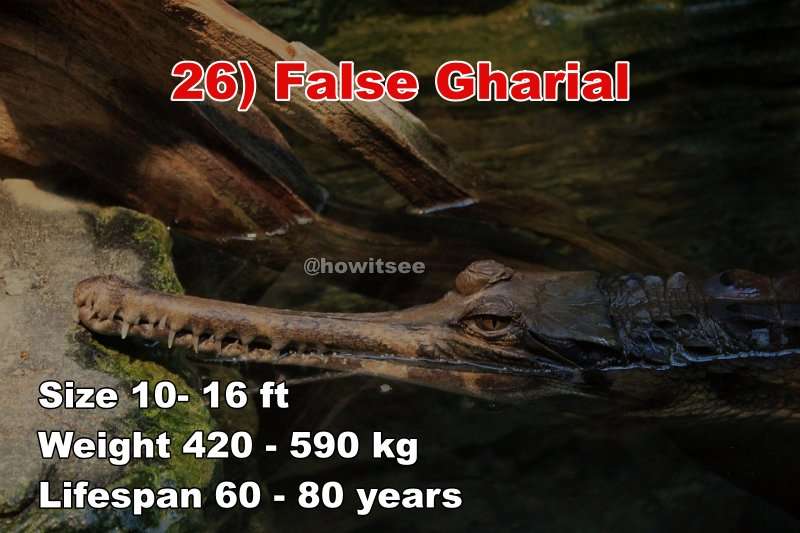
| Scientific name | Tomistoma schlegelii |
| Size | Male: 12 – 16 ft
Female: 10 – 13 ft |
| Weight | 420 – 590 kg |
| Lifespan | 60 – 80 years |
| Diet | Fish, small aquatic animals, all sorts of terrestrial animals |
False Gharials are called so because of their physical resemblance to the gharials, their relatives. They are found in Southeast Asia where they prefer to live in mud holes, swamps, lakes and flooded forests. They are capable predators and prey on both terrestrial and aquatic animals.
31) Gharial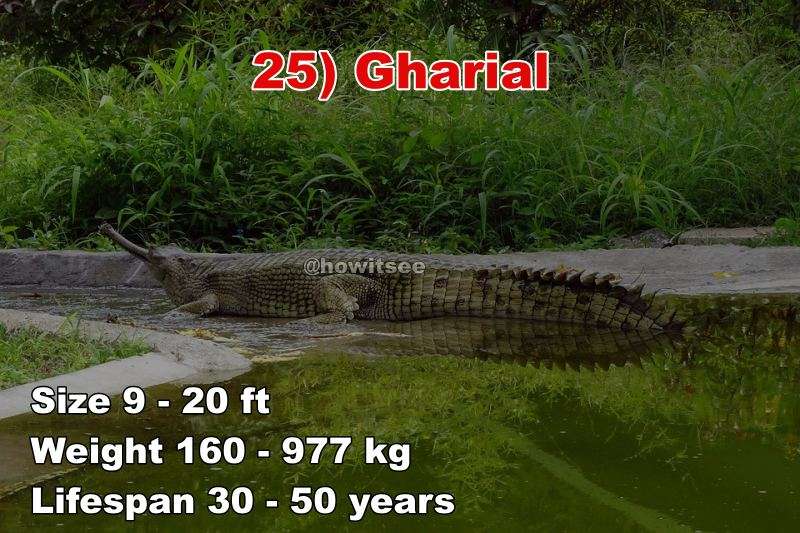
| Scientific name | Gavialis gangeticus |
| Size | Male: 9 – 20 ft
Female: 8.5 – 15 ft |
| Weight | 160 – 977 kg |
| Lifespan | 30 – 50 years |
| Diet | Fish, insects, frogs, snakes, turtles, birds, mammals, dead animals |
Gharials are the Critically Endangered relatives of crocodiles, found in Southeast Asia. They get their name from the bulbous growth on the tips of the snouts of male gharials which resembles the round pots known as “ghara” in Hindi. Gharials are very dedicated parents and protective towards their young.
30) Southern Elephant Seal
| Scientific name | Mirounga leonina |
| Size | Male: 16 – 20 ft
Female: 10 ft |
| Weight | Male: 2,200 – 4,000 kg
Female: 400 – 900 kg |
| Lifespan | 21 years |
| Diet | Squids, fish |
Southern Elephant Seals are huge creatures and among the biggest animals in the world. They are very social in nature and prefer to stay in groups. The seals are carnivorous and eat mainly squids and fish. They get their name from the proboscis of the males, which resemble an elephant’s trunk.
29) Colossal Squid
| Scientific name | Mesonychoteuthis hamiltoni |
| Size | It has maximum estimated total length of 9–10 meters (30–33 feet) |
| Weight | 600–700 kilograms (1,300–1,500 pounds) |
| Lifespan | NA |
| Diet | Chaetognatha, large fish like the Patagonian toothfish, and smaller squid in the deep ocean. |
The colossal squid has the largest eyes of any known creature, with an estimated diameter of 27 cm (11 in). Its eyes are adapted to overcome visual complications in the pelagic zone, allowing it to detect predator movement beyond 120 meters, potentially outpacing the sonar range of sperm whales, one of its main predators.
Their eyes glow in the dark, facilitated by long, rectangular light-producing photophores located next to the lens. Symbiotic bacteria within these photophores luminesce through a chemical reaction, contributing to the squid’s unique visual adaptations.
28) American Crocodile
| Scientific name | Crocodylus acutus |
| Size | Male: 13 – 16 ft
Female: 9.8 ft |
| Weight | Male: 400 – 500 kg
Female: 170 kg |
| Lifespan | 47 – 70 years |
| Diet | All kinds of aquatic and terrestrial prey |
American Crocodiles are carnivorous and opportunistic predators. They prey on all sorts of prey within their reach. These crocodiles are also comfortable in a large variety of habitats, including freshwater, swamp and even saltwater, though juvenile crocodiles can’t endure saltwater. According to IUCN, they are currently a Vulnerable species.
27) Black Caiman
| Scientific name | Melanosuchus niger |
| Size | 16 – 20 ft |
| Weight | 350 – 1,100 kg |
| Lifespan | 50 – 80 years |
| Diet | All sorts of aquatic and terrestrial prey |
Black Caiman are South American natives who are at the top of the food chain. These apex predators have no natural predators for themselves and thus prey on all kinds of animals, no matter how big. They prefer to be warm and like to bask in the sun with mouths open.
26) Goblin Shark
| Scientific name | Mitsukurina owstoni |
| Size | The goblin shark typically reaches a mature length of 3 to 6 meters (10 to 20 feet) |
| Weight | 210 kg (460 lb). An individual, heavily pregnant, was reported to weigh 800 kg at 4.7 meters. |
| Lifespan | Around 16 years, with a potential lifespan of up to 60 years. |
| Diet | Teleost fishes like rattails and dragonfishes, cephalopods, and crustaceans. |
The goblin shark is often referred to as a “living fossil” due to its lineage dating back approximately 125 million years, making it the only extant representative of the family Mitsukurinidae.
It exhibits a unique feeding mechanism known as “slingshot feeding.” The protrusion of the jaws is assisted by elastic ligaments, and the lower jaw undergoes complex movements, allowing the goblin shark to capture prey efficiently, compensating for its relatively poor swimming ability.
25) Nile Crocodile
| Scientific name | Crocodylus niloticus |
| Size | Male: 11 – 16.5 ft; Female: 7 – 13 ft |
| Weight | Male: 150 – 750 kg; Female: 40 – 250 kg |
| Lifespan | 50 – 60 years |
| Diet | All sorts of prey |
Nile Crocodiles are the second largest living crocodile in the world, after the Saltwater Crocodile. They are also the largest freshwater predator in the African continent. These crocodiles are extremely dangerous and cause a huge number of human deaths every year.
24) Steller’s Sea Lion
| Scientific name | Eumetopias jubatus |
| Size | Males: 2.82–3.25 meters
Females: 2.3–2.9 meters |
| Weight | Males: 450–1,120 kg
Females: 240–350 kg |
| Lifespan | Around 20-30 years |
| Diet | Walleye pollock, Atka mackerel, halibut, herring, capelin, flatfish, Pacific cod, rockfish, sculpins, salmon, and cephalopods. |
Steller sea lions showcase adaptability in their diet, adjusting to locally abundant prey species, and even entering estuaries to feed on brackish-water fish like sturgeon.
They communicate both in air and underwater with distinctive vocalizations, crucial for mother-pup pairs in crowded breeding areas. Mothers and pups use specific calls, resembling names, to identify each other in the sea lion crowd, highlighting a unique social aspect of their communication.
23) Giant Squid
| Scientific name | Architeuthis dux |
| Size | Male: 33 ft
Female: 39 – 43 ft |
| Weight | Male: 150 kg
Female: 275 kg |
| Lifespan | 5 years |
| Diet | Deep sea fish, squids |
Among all these large vertebrates, the Giant Squid takes its place as one of the biggest animals in the world. It is also the biggest invertebrate in the world. Along with the colossal squids, giant squids have the largest eyes out of all animals, which help them see in the deeper parts of the ocean.
22) African Elephant Seal
| Scientific name | The northern elephant seal is Mirounga angustirostris, while the southern elephant seal is Mirounga leonina. |
| Size | Elephant seals are impressively large, with males reaching lengths of up to 6 meters (20 feet) in the southern species and up to 4.8 meters (16 feet) in the northern species. |
| Weight | Male: 5,000 kilograms (11,000 pounds) in the southern species Male: 2,500 kilograms (5,500 pounds) in the case of northern elephant seals. |
| Lifespan | Northern elephant seal: 9 years
Southern elephant seal: 21 years |
| Diet | Elephant seals have a diverse diet that includes skates, rays, squid, octopuses, eels, small sharks, and large fish |
Elephant seals come equipped with an extraordinary internal thermostat, a physiological adaptation that helps conserve energy and prevent heat loss. By smartly orchestrating the flow of blood through their arteries and veins, these seals stay cozy and comfortable even in the chilly depths of the ocean.
21) Great White Shark
| Scientific name | Carcharodon carcharias |
| Size | Male: 11 – 13 ft
Female: 15 – 16 ft |
| Weight | 522 – 1,111 kg |
| Lifespan | 70 years |
| Diet | Tuna, rays, sharks, whales, dolphins, porpoises, seals, fur seals, sea lions, sea turtles, sea otters, sea birds |
Though “Jaws” have made them famous as frightening creatures, Great White Sharks are in reality quite temperate and rarely prey on humans. Though they have about 300 teeth and their fallen teeth are replaced by new plates; they don’t chew their food. They also prefer to live in warm water.
20) African Forest Elephant
| Scientific name | Loxodonta cyclotis |
| Size | Length: 10 – 13 ft
Height: 6 – 10 ft |
| Weight | 2 – 7 tonnes |
| Lifespan | 60 – 70 years |
| Diet | Vegetation |
African Forest Elephants are the smallest living elephant species. They live in the deep rainforests of Africa and are difficult to come by. Because of their primary diet of fruits, they play an important role in spreading seeds around the forest and are known as the “mega-gardener of the forest.” Sadly, they are also Critically Endangered.
19) Beluga Whale
| Scientific name | Delphinapterus leucas |
| Size | Male: 11 – 18 ft
Female: 10 – 13.5 ft |
| Weight | Male: 1,100 – 1,600 kg
Female: 700 – 1,200 kg |
| Lifespan | 30 years |
| Diet | Arctic cods, rose fish, Greenland halibut, northern shrimp, Coho salmon, capelin, smelt, flounder, herring, crabs, soles, sculpins, squids, clams, octopuses, sea snails, bristle worms |
Beluga Whale is a beautiful species of whales, noted for their pure white color. They are very vocal and known as “sea canaries“. They have some fierce predators in polar bears and killer whales.
18) Saltwater Crocodile
| Scientific name | Crocodylus porosus |
| Size | Male: 20 – 21 ft
Female: 9 – 11 ft |
| Weight | Male: 1,000 – 1,300 kg
Female: 76 – 200 kg |
| Lifespan | 70 – 80 years |
| Diet | Fish, turtles, goannas, snakes, cattle, birds, buffalos, wild boar, mud crabs |
Saltwater Crocodiles are the largest living reptile and have the strongest bite in the world. They have been on this planet for a very long time, going back as far as the dinosaurs. These crocodiles are apex predators and will prey on anything in their reach. While they might hunt underwater, they will only feed above the surface.
17) Long-finned pilot whale
| Scientific name | Globicephala melas |
| Size | Males: 7.6 meters (25 feet)
Females: 6 meters (20 feet) |
| Weight | Males: 4,500 kg (9,900 lb)
Females: 2,500 kg (5,500 lb) |
| Lifespan | 45 to 60 years |
| Diet | Various species of squid, octopus, crustaceans, and fish, including Lanternfish, Atlantic herring, Silver hake, Atlantic mackerel, and Spiny dogfish. |
Long-finned pilot whales are recognized for their extensive social behavior, often forming small long-term social units consisting of around 8-12 individuals.
It possesses a unique vocal repertoire, producing various sounds, including echolocation clicks for bio-sonar. Recent studies indicate that a significant portion of their vocalizations consists of repeated sequences, particularly during socializing behaviors, such as lobtailing and spyhopping.
16) Orca (Killer Whale)
| Scientific name | Orcinus orca |
| Size | Males: 20 – 26 ft
Female: 16 – 23 ft |
| Weight | Male: 6 tonnes
Female: 3 – 4 tonnes |
| Lifespan | Males: 10 – 30 years (in captivity)
Female: 50 – 80 years |
| Diet | Fish, cephalopods, mammals, seabirds, sea turtles |
Though Orcas are famous as killer whales, they are not actually whales, rather dolphins. Orcas are not only one of the biggest animals in the world, they are also the most widespread mammal on the planet. They also have the second largest brain out of all marine mammals.
15) Asian Elephant
| Scientific name | Elephas maximus |
| Size | Length: 18 – 21 ft
Height: 8 – 9 ft |
| Weight | 3 – 5 tonnes |
| Lifespan | 60 – 80 years |
| Diet | Vegetation |
Asian Elephants are the second largest of the three living elephant species and smaller only to the African bush elephant. Apart from the size, there are some differences between the Asian elephant and its African counterparts. For example, the ears of the Asian elephants are smaller and they have one extra toenail on each foot.
14) African Bush Elephant
| Scientific name | Loxodonta africana |
| Size | Length: 24 ft
Height: 13 ft |
| Weight | 3 – 6 tonnes |
| Lifespan | 70 – 75 years |
| Diet | Vegetation |
The African Bush Elephant is the largest elephant species and one of the biggest animals in the world. They are also known as African Savannah Elephants. These elephants are the largest terrestrial animals in the world. Regrettably, they are now an Endangered species because of poaching and habitat destruction.
13) Basking Shark
| Scientific name | Cetorhinus maximus |
| Size | 23 – 36 ft |
| Weight | 16 tonnes |
| Lifespan | 50 years |
| Diet | Zooplanktons, copepods, very small fish |
Armed with a frightening set of teeth, Basking Sharks are the second largest fish in the world. Despite their appearance, they are mild-mannered creatures and are not predatory. They are filter feeders and their diet primarily consists of zooplanktons and tiny fish.
12) Whale Shark
| Scientific name | Rhincodon typus |
| Size | 26 – 59 ft |
| Weight | 14 tonnes |
| Lifespan | 80 – 130 years |
| Diet | Copepods, krills, fish, fish eggs, squids, crabs |
The position of the largest fish in the world is taken by the Whale Shark. Like their smaller shark friend, they are also filter feeders. While their name contains two different animals, they are in fact a shark, not a whale.
11) Gray Whale
| Scientific name | Eschrichtius robustus |
| Size | 42 – 49 ft |
| Weight | 41 tonnes |
| Lifespan | 55 – 70 years |
| Diet | Benthic crustaceans, amphipods, isopods |
Whales are undoubtedly the biggest creatures out there and from here on, the list completely consists of whales. Gray Whales are one of those large animals. Like all whales, they are also bottom feeders. Adult male gray whales are slightly smaller than adult females.
10) Humpback Whale
| Scientific name | Megaptera novaeangliae |
| Size | 46 – 60 ft |
| Weight | 36 – 40 tonnes |
| Lifespan | 80 – 90 years |
| Diet | Krill, herring, capelin, sand lances, Atlantic mackerel |
The name of Humpback Whales comes from the distinctive hump at the front of their small dorsal fins. The geographical distribution of these whales are wide and ranges around the world. They also migrate very long distances.
9) Bryde’s Whale
| Scientific name | Balaenoptera brydei |
| Size | Males: About 12.9 meters (42 feet)
Females: 13.3 meters (44 feet) |
| Weight | 12 to 25 metric tons |
| Lifespan | 50 to 70 years in the wild |
| Diet | Wide range of prey including fish (such as anchovies and sardines), planktonic crustaceans (euphausiids), and cephalopods. |
Bryde’s whales are known for their erratic behavior compared to other baleen whales, often surfacing at irregular intervals and changing directions for unknown reasons.
Although not significantly targeted by historical commercial whaling, Bryde’s whales face threats from ship strikes and anthropogenic noise.
8) Bowhead Whale
| Scientific name | Balaena mysticetus |
| Size | 49 – 62 ft |
| Weight | 54 – 100 tonnes |
| Lifespan | Over 200 years |
| Diet | Copepods, amphipods, crustaceans |
Bowhead Whales, true to their name, have huge heads. In fact, their skull takes up about a third of their body. They use their skulls to break sea ice. These whales also have the thickest blubber out of all whales.
7) North Atlantic Right Whale
| Scientific name | Eubalaena glacialis |
| Size | 43 – 52 ft |
| Weight | 40 – 70 tonnes |
| Lifespan | 70 years |
| Diet | Copepods, krills, pteropods, larval barnacles |
North Atlantic Right Whales are the smallest of the three species of right whales. During the 1890s, these whales faced near extinction because of hunting by commercial whalers.
6) Sei Whale
| Scientific name | Balaenoptera borealis |
| Size | Male: 45 – 61 ft
Female: 49 – 64 ft |
| Weight | Male: 15 – 17 tonnes
Female: 18.5 tonnes |
| Lifespan | 70 years |
| Diet | Copepods, krills, other zooplanktons, small fish |
Sei Whale is another Baleen whale which is one of the biggest animals in the world. They can swim very fast, up to the speed of 34 mph. Sei whales have a distinct way of diving where they just sink below the surface without arching or displaying their flukes.
5) Sperm Whale
| Scientific name | Physeter macrocephalus |
| Size | Male: 49 – 62 ft
Female: 35 – 39 ft |
| Weight | Male: 41 – 53 tonnes
Female: 14 tonnes |
| Lifespan | 70 years or more |
| Diet | Squids, octopuses, demersal rays, sharks |
Sperm Whales have the biggest brain out of all living animals. They are also the largest toothed whales. Their name comes from the semi-liquid substance in their head which was initially believed to be sperms.
4) Southern Right Whale
| Scientific name | Eubalaena australis |
| Size | 49 – 59 ft |
| Weight | 80 – 90 metric tons |
| Lifespan | Over 100 years |
| Diet | Zooplanktons |
Southern Right Whales inhibit the waters of the Southern Hemisphere. The calluses on their bodies are unique to each whale and act as identifiers. They are also very calm and slow in nature.
3) North Pacific Right Whale
| Scientific name | Eubalaena japonica |
| Size | 49 – 60 ft |
| Weight | 50 – 100 tonnes |
| Lifespan | 70 years |
| Diet | Copepods, krills |
The North Pacific Right Whales are an Endangered species of Baleen whales. They are huge in size and make a wide range of noises, dubbed as screams, moans, groans, pulses and belches by scientists.
2) Fin Whale
| Scientific name | Balaenoptera physalus |
| Size | 61 – 66 ft |
| Weight | 57 – 120 metric tons |
| Lifespan | 94 – 140 years |
| Diet | Small fish, squids, copepods, krills |
Fin Whales are also a species of Baleen whales and the second largest animal in the world. They are solitary in nature and prefer to roam alone. Their only known natural predator is the killer whale.
1) Blue Whale
| Scientific name | Balaenoptera musculus |
| Size | 72.1 – 108 ft |
| Weight | 83.5 – 100 tonnes |
| Lifespan | 80 – 90 years |
| Diet | Krill |
The biggest animal in the world is the Blue Whale. This deep sea whale is not only the biggest living animal but it is also the biggest animal ever to have lived on Earth. Just their tongues weigh as much as an elephant. Blue whales are also the loudest animal on this planet; their sounds are around 188 decibel which is louder than a jet engine.
There are some unbelievably huge animals we have in our planet. But very sadly, a lot of them are facing habitat loss and decreasing numbers. There are many species here that are either endangered or vulnerable, and some are even critically endangered. It’s unfortunate that humans are responsible for this. We must protect them to keep balance in our world. We’ll stop here for now. Go visit our website for more exciting contents like this.
References
Wikipedia, Animals Comparisons, The Nature Conservancy, Oceana, NOAA Fisheries, Ocean, Smithsonian’s National Zoo and Conservation Biology Institute, San Diego Zoo Wildlife Alliance Library, The Animal Files, Britannica, NT Government (Be Crocwise), Animal Spot, Kidadl, Animal Diversity Web, Australian Antarctic Program, LA Zoo, PetMD, The Peregrine Fund, The Dodo, Treehugger, WorldWildLife, Factins, NWF Blog, ZSL, Though Co.
Also Read:

Hi everyone, my name is Shawna, and I’ve always been fascinated by the fascinating diversity of flora and fauna that our nature has in it. I am currently studying biotechnology and am particularly interested in animal biotechnology, delving into the intricate processes that define their true nature and uniqueness.
